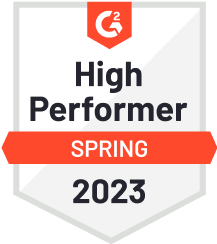
Agile collaboration is the process of teams working together through iterative planning, execution, and feedback cycles to achieve shared goals with adaptability and transparency. It combines Agile principles with collaborative practices to ensure teams stay aligned, communicate openly, and respond quickly to change.
Unlike traditional collaboration methods that rely on rigid hierarchies and long planning cycles, Agile collaboration promotes flexibility, shared ownership, and continuous improvement. It encourages cross-functional teamwork, where developers, designers, marketers, and other stakeholders work closely to deliver incremental value and adjust priorities based on real-time feedback.
This approach enhances communication, accountability, and delivery speed, enabling organizations to create better products, reduce risks, and adapt seamlessly to evolving customer and market needs. Agile collaboration is used in industries like software development, marketing, product design, and service delivery to improve productivity and encourage innovation.
In this article, we discuss what Agile collaboration is, its benefits, core principles, effective techniques to build it, challenges teams often face, and how to solve them, along with some examples that show how it drives high-performing, adaptive teams.
What is Agile collaboration?
Agile collaboration is a structured approach of teams working together through iterative planning, execution, and feedback cycles to achieve shared goals with flexibility and transparency.
It integrates Agile principles into team communication and workflow management, ensuring that members align continuously, adapt quickly to change, and take collective ownership of outcomes.
Agile collaboration bridges functional silos by promoting cross-functional teamwork, open information sharing, and continuous learning.
Effective Agile collaboration requires clear visibility of tasks, real-time communication, and the use of Agile project management tools to coordinate work efficiently. This approach enhances adaptability, accountability, and consistent value delivery across teams.
What are the benefits of Agile collaboration?
Agile collaboration benefits teams by increasing adaptability, improving communication, accelerating delivery, and strengthening accountability through shared ownership and continuous feedback.

Here is how Agile collaboration drives team performance and organizational success:
- Improves adaptability: Agile collaboration enables teams to respond quickly to change by working in short, iterative cycles. Continuous review and feedback ensure priorities are realigned according to evolving customer or business needs.
- Enhances communication and transparency: Frequent stand-ups, retrospectives, and visual task boards promote open communication and transparency. Every member knows project status, dependencies, and blockers, reducing miscommunication and delays.
- Increases accountability and ownership: Shared decision-making builds collective responsibility. Team members understand how their contributions impact project goals, fostering a culture of accountability and trust.
- Improves customer satisfaction: Regular feedback loops with stakeholders and clients ensure that deliverables match expectations. Teams deliver more relevant, high-quality outcomes that satisfy customer needs effectively.
- Reduces project risks: Iterative delivery identifies potential issues early, allowing immediate corrective actions. This reduces overall project risk and prevents large-scale failures.
- Enhances morale and engagement: Active participation, equal contribution, and visible impact of work improve motivation, engagement, and job satisfaction across teams.
- Achieves faster time-to-market: By removing silos and promoting real-time decision-making, Agile collaboration helps teams deliver products or services faster, improving competitiveness and responsiveness.
What are the core principles of Agile collaboration?
The core principles of Agile collaboration centred around daily cross-functional collaboration, continuous customer focus, empowered teams, open dialogue, self organization, and continuous improvement.
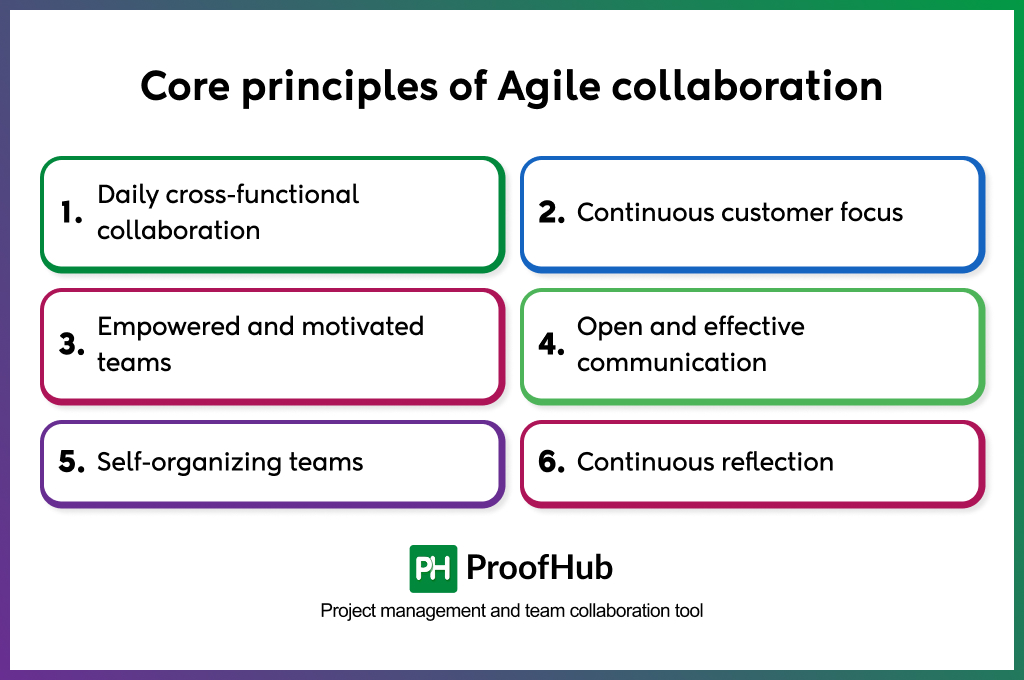
Here are the core principles that drive Agile collaboration:
- Daily cross-functional collaboration
One of the core Agile principles states that business stakeholders and developers must work together daily throughout the project. Regular interaction between technical and non-technical members breaks down silos, ensures shared understanding, and speeds up decision-making. This close alignment helps teams identify issues early and adapt in real-time.
- Continuous customer focus
Agile collaboration begins with a shared commitment to delivering customer value. Teams work closely with customers to understand needs, gather feedback, and adapt solutions quickly. This ongoing engagement ensures every iteration moves closer to what the customer truly wants, aligning the entire team around a single purpose.
- Empowered and motivated teams
Agile collaboration thrives in environments where individuals are trusted and empowered. When teams have autonomy and clarity, they take greater ownership of outcomes. Leaders support rather than control, building accountability and encouraging open exchange of ideas – essential for collaborative success.
- Open and effective communication
Face-to-face conversation, whether physical or virtual, remains the most effective form of communication in Agile. Direct discussions help teams clarify goals, resolve misunderstandings, and maintain momentum without delays caused by lengthy documentation or misaligned assumptions.
- Self-organizing teams
Agile collaboration depends on self-organizing teams that decide how best to accomplish their work. These teams manage their own processes, distribute tasks based on strengths, and adapt roles as needs change. Self-organization promotes creativity, flexibility, and mutual respect – the hallmarks of high-performing collaborative teams.
- Continuous reflection and improvement
Agile collaboration isn’t static; it evolves through regular retrospectives. Teams periodically reflect on how they work together, identify obstacles, and implement small, continuous improvements. This principle ensures collaboration remains healthy, productive, and aligned with changing project demands.
How to build Agile collaboration in teams?
To build Agile collaboration in teams, create environments that promote transparency, empower decision-making, enable adaptability, and sustain a shared sense of ownership.
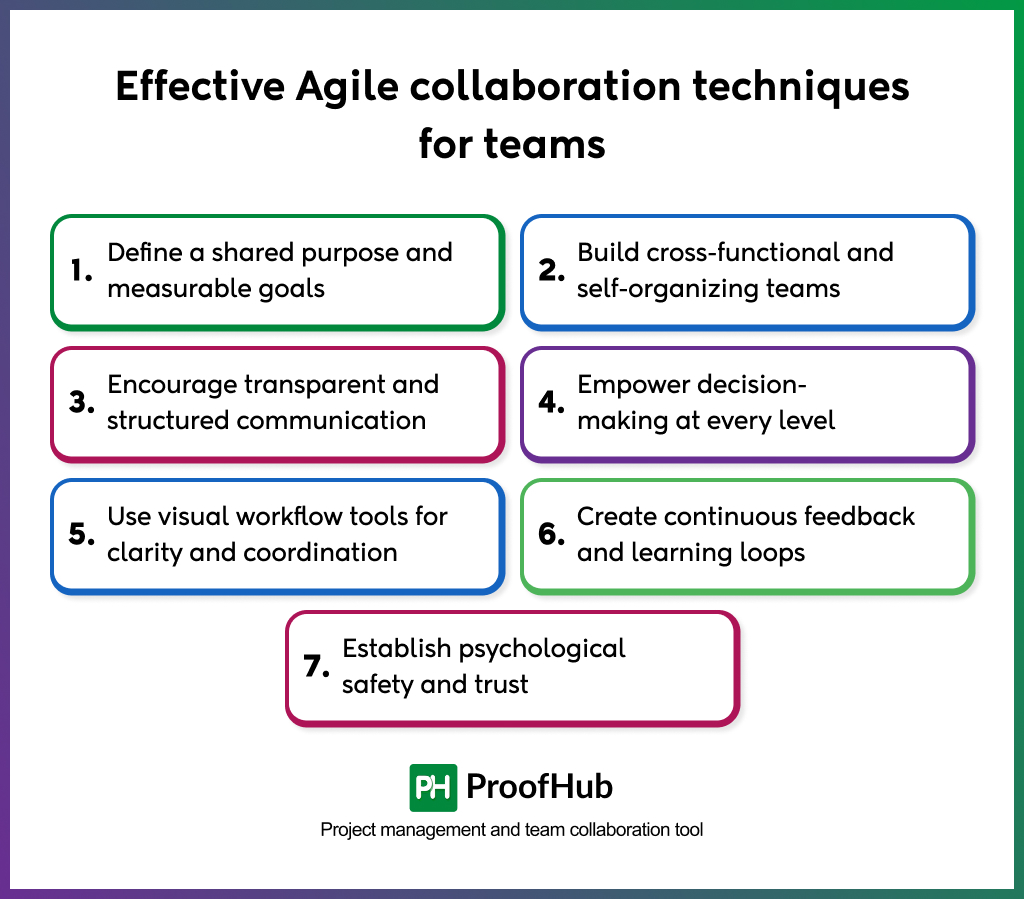
Some effective Agile collaboration techniques for teams are:
1. Define a shared purpose and measurable goals
Agile collaboration begins with a clear and shared purpose that connects team activities to business outcomes. When every member understands why the work matters, alignment and motivation follow naturally.
Define measurable goals for each iteration or sprint using frameworks like OKRs (Objectives and Key Results) or sprint targets. Regularly review progress against these metrics to ensure that collaboration efforts continue to drive collective value. A unified direction prevents misalignment and keeps all contributors focused on outcomes rather than individual tasks.
2. Build cross-functional and self-organizing teams
Cross-functional teams eliminate silos by combining complementary expertise such as design, development, operations, and testing within a single collaborative unit. Self-organization allows members to manage work distribution, resolve blockers, and adjust scope dynamically without managerial delays.
This diversity in skills increases adaptability, promotes innovation through different viewpoints, and ensures accountability across the entire workflow. Empowering such teams with autonomy is fundamental to maintaining agility and responsiveness.
3. Encourage transparent and structured communication
Transparency boosts trust and collaboration. Structured communication through daily stand-ups, retrospectives, and sprint reviews ensures that information flows continuously and no issue remains hidden.
Teams should use digital channels and project dashboards where updates, blockers, and dependencies are visible in real time. Clear communication standards (what to share, when, and how) help avoid overload while ensuring every member remains informed and engaged.
4. Empower decision-making at every level
Agile collaboration thrives when decision-making authority is distributed. Empowering individuals to make decisions within their area of expertise accelerates execution and increases accountability.
Leaders should act as facilitators rather than controllers, removing obstacles and providing context for better decisions. Empowered teams feel trusted and responsible for outcomes, which enhances ownership and commitment to goals.
5. Use visual workflow tools for clarity and coordination
Visual management systems translate complex workflows into clear, interactive formats that everyone understands. Collaboration tools make task ownership, progress, and dependencies visible to all stakeholders.
This visibility simplifies coordination, enables real-time adjustments, and ensures that collaboration remains efficient even in remote or distributed teams. Visualization bridges communication gaps and keeps everyone synchronized.
6. Create continuous feedback and learning loops
Agile collaboration depends on frequent feedback from both team members and stakeholders. Retrospectives, sprint reviews, and regular performance check-ins help teams identify inefficiencies and implement improvements quickly.
Feedback should be structured, actionable, and consistent across cycles. This loop of learning and refinement creates a culture of continuous improvement, where each iteration becomes better than the last in quality, collaboration, and delivery.
7. Establish psychological safety and trust
Psychological safety is the foundation of collaborative agility. When team members feel safe to share ideas, admit mistakes, or challenge assumptions without fear, creativity and innovation flourish.
Trust is built through consistency, respect, and transparency in decision-making. Recognizing contributions, celebrating small wins, and maintaining fairness in workload distribution reinforce a positive collaborative culture. High-trust environments enable teams to stay resilient and adaptable even under pressure.
What are the challenges of Agile collaboration?
The challenges of Agile collaboration include unclear communication, resistance to change, lack of accountability, tool fragmentation, inconsistent feedback, role confusion, and difficulty maintaining transparency.
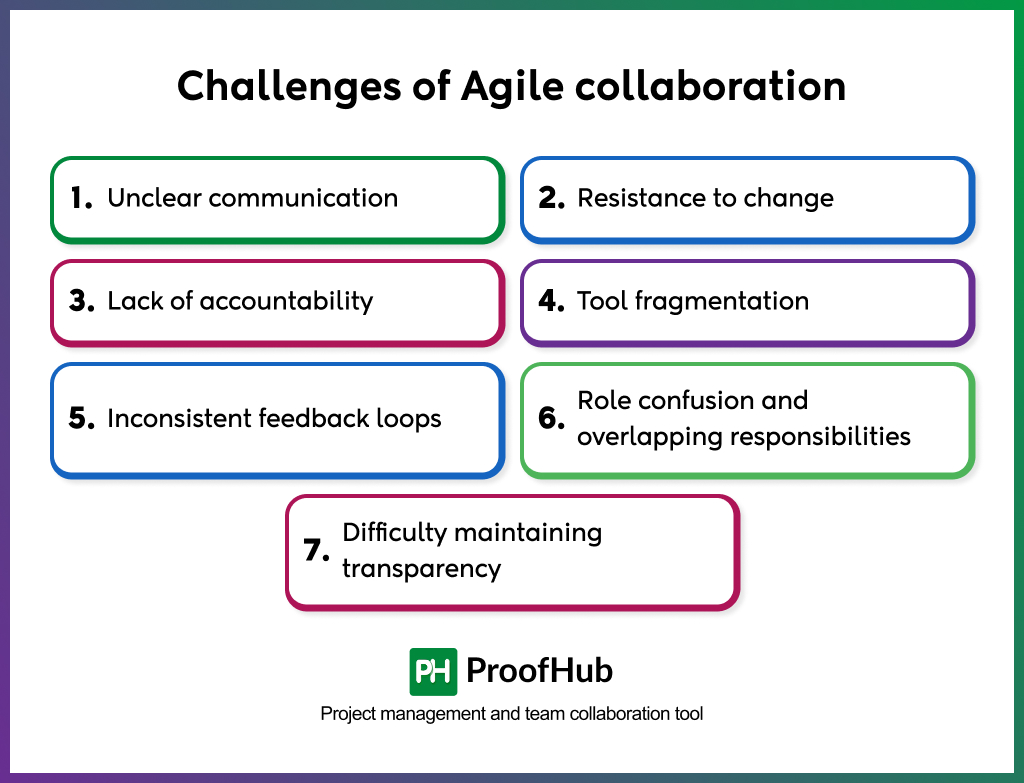
Here are the most common challenges of Agile collaboration and how to address them effectively:
1. Unclear communication: Teams often face communication breakdowns when updates are inconsistent, scattered across tools, or limited to specific individuals. This creates misalignment, duplicated effort, and delays in decision-making.
Address this challenge by implementing structured communication systems such as daily stand-ups, shared dashboards, and centralized chat channels. Ensure that updates, blockers, and priorities are shared in one accessible workspace for all members.
2. Resistance to change: Shifting from traditional hierarchical structures to Agile collaboration triggers resistance, especially among teams accustomed to command-and-control decision-making. Such resistance limits flexibility and slows adoption.
Overcome this by educating teams about Agile principles, showing tangible success stories, and introducing changes gradually. Model Agile behavior like transparency, openness, and adaptability to reinforce acceptance.
3. Lack of accountability: When teams operate with shared ownership but without defined boundaries, accountability blurs. Missed deadlines, scope creep, or unclear responsibilities often result.
Solve this by defining clear roles, responsibilities, and ownership models using frameworks like RACI or Scrum roles (Product Owner, Scrum Master, Development Team). Regular progress tracking and public reporting of deliverables maintain accountability without micromanagement.
4. Tool fragmentation: Using multiple, unintegrated tools for communication, task management, and documentation leads to scattered information and confusion. Fragmentation disrupts collaboration and wastes time switching between systems.
Minimize this challenge by standardizing tool usage across the team. Use centralized platforms to manage tasks, discussions, files, and reports in one space. Integration between tools should be automated to maintain workflow consistency.
5. Inconsistent feedback loops: Irregular or unclear feedback prevents continuous improvement and demotivates teams. Without structured reviews, lessons learned are lost, and recurring issues remain unresolved.
Establish predictable feedback cycles (sprint reviews, retrospectives, and stakeholder check-ins) to keep learning active. Ensure that feedback is actionable, documented, and followed up in the next iteration.
6. Role confusion and overlapping responsibilities: Agile teams sometimes struggle with unclear roles, especially when traditional managers and cross-functional teams coexist. This overlap causes conflict, duplicated work, and confusion in decision-making.
Clarify team structure and define ownership boundaries early. Every member should know what they’re responsible for and who to collaborate with. Using visual workflow mapping helps ensure clarity and prevent overlap.
7. Difficulty maintaining transparency: Transparency is central to Agile collaboration, yet keeping it becomes hard when teams scale or work remotely. Hidden progress, private decisions, or delayed reporting weakens visibility and trust.
Resolve this by maintaining shared dashboards, open communication channels, and visible progress reports accessible to everyone. Consistent visibility builds alignment and trust, enabling informed and timely decisions.
Examples of Agile collaboration
Some examples of Agile collaboration are:
Example 1: Software product development
A cross-functional Agile team developing a new SaaS feature includes developers, testers, UX designers, and a product owner. Each sprint focuses on building, testing, and refining user stories.
Daily stand-ups help identify blockers early, while retrospectives encourage improvement. By using a shared Kanban board and continuous integration tools, the team delivers updates faster and adapts to customer feedback in real-time.
Example 2: Product launch across departments
When a company prepares to launch a new product, marketing, design, sales, and engineering teams collaborate through Agile sprints. Each sprint focuses on a launch milestone, including content creation, demo readiness, or campaign testing.
Regular syncs and shared progress boards keep everyone aligned, while sprint reviews help teams adapt based on early customer feedback. This Agile approach breaks down silos, accelerates execution, and ensures a unified go-to-market strategy.
Example 3: Product design sprint
During a design sprint for a new app interface, product managers, designers, and developers collaborate to prototype, test, and refine user experiences within a week.
Daily collaboration sessions and rapid feedback loops enable the team to identify usability issues early and innovate faster. Agile collaboration helps the team make informed decisions quickly, reducing development time and ensuring user-centered design outcomes.
Which tools are best for agile collaboration?
Agile collaboration relies on digital tools such as project management software, communication apps, team collaboration tools, document and knowledge-sharing platforms, and integrated project hubs that support planning, communication, documentation, and performance tracking to keep Agile workflows adaptive and efficient.
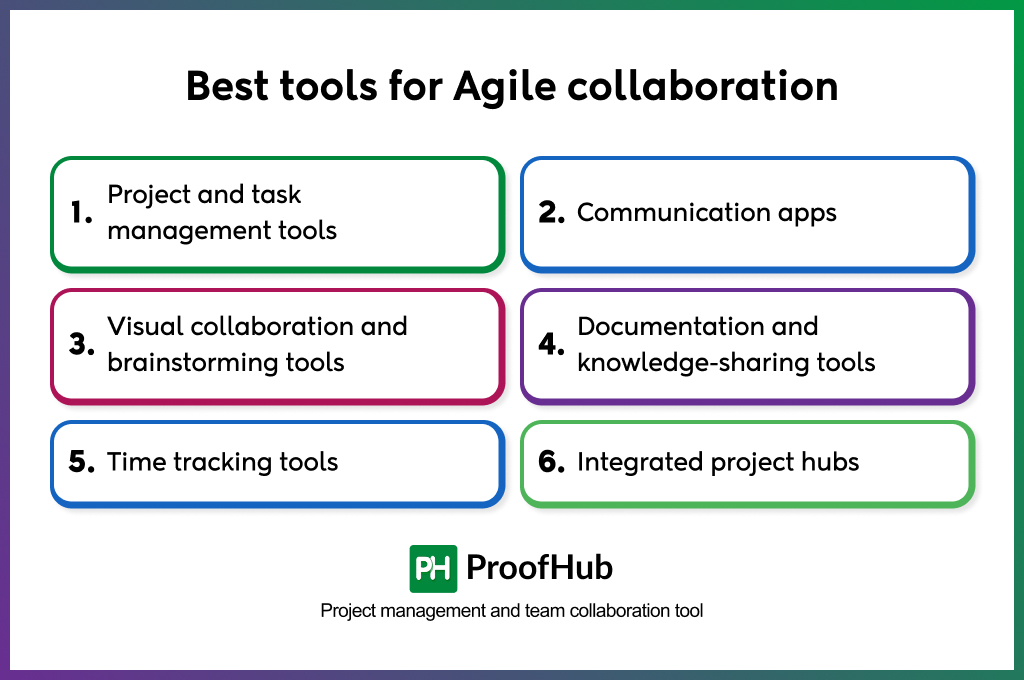
Here are some tools that are best for Agile collaboration:
- Project and task management tools: These tools organize sprints, track progress, and manage backlogs in one workspace. They help teams visualize tasks, set priorities, and maintain accountability throughout iterations. Examples include ProofHub, Jira, and ClickUp, which support Kanban boards, task dependencies, and milestone tracking to keep Agile projects on schedule.
- Communication apps: Effective communication tools enable fast, transparent collaboration among cross-functional teams. Platforms like Slack and Microsoft Teams facilitate daily stand-ups, instant messaging, and topic-based channels to ensure alignment and quick decision-making.
- Visual collaboration and brainstorming tools: Digital whiteboards such as Miro and Lucidspark help teams brainstorm, plan sprints, and visualize workflows. They replicate physical collaboration spaces, allowing distributed teams to co-create ideas, map user stories, and design product features visually.
- Documentation and knowledge-sharing tools: Centralized documentation tools like Confluence, Notion, and Google Workspace store user stories, retrospectives, and product requirements for easy reference. These tools enable real-time co-editing, ensuring teams retain context, share insights, and avoid information silos.
- Time tracking tools: Accurate time tracking maintains balance and efficiency in Agile cycles. Tools like Harvest, Toggl Track, and Clockify record effort per sprint, helping teams evaluate productivity, refine estimates, and optimize workload distribution.
- Integrated project hubs: All-in-one platforms such as ProofHub combine task management, team chat, file sharing, time tracking, and reporting in a single system. By centralizing Agile workflows, these tools reduce fragmentation, improve visibility, and strengthen accountability across teams.
What is the difference between Agile collaboration and traditional collaboration?
The main difference between Agile collaboration and traditional collaboration lies in how teams plan, execute, and respond to change.
- Agile collaboration is iterative, flexible, and people-centric. It emphasizes continuous communication, adaptive planning, and quick feedback cycles. Teams work in short iterations (sprints), review progress frequently, and adjust direction based on feedback. For instance, a cross-functional team releasing product updates every two weeks based on user feedback demonstrates Agile collaboration.
- Traditional collaboration, on the other hand, follows a structured, sequential approach where work is divided into phases – planning, execution, review, and delivery. Communication typically flows top-down, decisions are centralized, and progress is measured against predefined plans. For example, a project team working through a detailed annual plan with fixed milestones and limited scope for iteration represents traditional collaboration.
How does agile collaboration improve team accountability and ownership?
Agile collaboration improves team accountability and ownership by replacing top-down control with shared responsibility, transparency, and empowerment. Teams commit to goals collectively and work in short, iterative cycles where progress is visible through tools like task boards, stand-ups, and retrospectives. This visibility keeps everyone aligned and accountable for outcomes.
Regular feedback loops and self-managed planning encourage members to take ownership of both successes and failures. By empowering teams to make decisions, solve problems collaboratively, and continuously improve processes, Agile builds a culture where accountability is internalized and ownership becomes part of everyday work.
How does agile collaboration enhance innovation and problem-solving?
Agile collaboration enhances innovation and problem-solving by creating an environment of continuous learning, experimentation, and open feedback. Teams work in cross-functional groups that bring diverse perspectives together, enabling faster idea generation and better solutions.
Frequent iterations and reviews allow teams to test ideas quickly, learn from outcomes, and adapt without heavy bureaucracy. This flexibility encourages creativity while reducing the fear of failure.
Through transparent communication and shared ownership, Agile collaboration turns every sprint into an opportunity for innovation, helping teams identify challenges early, respond effectively, and deliver smarter, more user-focused outcomes.



